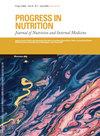Self-efficacy and cues to action: Two main predictors of modified version of diet quality index in Iranian adolescents
4区 医学
Q4 Agricultural and Biological Sciences
引用次数: 4
Abstract
Background: The purpose of this study was to examine the association between health belief model (HBM) constructs and a modified version of diet quality index in Iranian adolescents. Methods: One thousand and fifty five adolescents aged 13-15 years old completed this cross-sectional study. Participants were selected from secondary schools in Shiraz, one of the megacities of Iran, using stratified random sampling. A modified version of revised children’s diet quality index (M-RCDQI), was calculated for each adolescents and its association with the model construct was assessed using linear regression. Results: Mean M-RCDQI score was 58.91±8.58 out of the total of 90 points. Among the M-RCDQI components, the worse scores were obtained by dairy intake, dietary fiber and vegetables in which less than 20% of the students reached maximum score. Among HBM constructs, cues to action (B=0.194, p=0.003) and self-efficacy (B=0.04, p=0.007) had positive, significant association with adolescents’ diet quality. Also there was a positive, significant association between cues to action and fruits consumption (B=0.026, P=0.026), and a negative significant association was seen between cues to action and total fat intake (B=-0.629, p=0.021). Furthermore, self-efficacy had a direct significant association with dairy intake. Conclusion: M-RCDQI could be a suitable tool for assessment of diet quality index and it is recommended for use in further studies in similar populations. Cues to action and self-efficacy would both be effective mediators in improvement of nutritional behavior among adolescents.自我效能感和行动提示:伊朗青少年改良版饮食质量指数的两个主要预测因子
背景:本研究的目的是检验伊朗青少年的健康信念模型(HBM)结构与改良版饮食质量指数之间的关系。方法:一百五十五名13-15岁的青少年完成了这项横断面研究。参与者是从伊朗特大城市之一设拉子的中学中选择的,采用分层随机抽样。计算每个青少年的修订版儿童饮食质量指数(M-RCDQI),并使用线性回归评估其与模型构建的相关性。结果:90分中M-RCDQI平均得分为58.91±8.58分。在M-RCDQI成分中,乳制品摄入、膳食纤维和蔬菜得分最差,其中只有不到20%的学生达到最高得分。在HBM结构中,行动线索(B=0.194,p=0.003)和自我效能感(B=0.04,p=0.007)与青少年的饮食质量呈正相关。此外,行动提示与水果消费之间存在正相关(P=0.026,P=0.026),行动提示和总脂肪摄入量之间存在负相关(B=-0.629,P=0.021)。此外,自我效能感与乳制品摄入量有直接显著关联。结论:M-RCDQI可作为评估膳食质量指数的一种合适的工具,建议在类似人群的进一步研究中使用。行动提示和自我效能都是改善青少年营养行为的有效中介。
本文章由计算机程序翻译,如有差异,请以英文原文为准。
求助全文
约1分钟内获得全文
求助全文
来源期刊

Progress in Nutrition
医学-营养学
CiteScore
1.40
自引率
0.00%
发文量
0
审稿时长
>12 weeks
期刊介绍:
Progress in Nutrition was founded in 1999 as an independent magazine, a multidisciplinary approach, dedicated to issues of nutrition and metabolism.
 求助内容:
求助内容: 应助结果提醒方式:
应助结果提醒方式:


